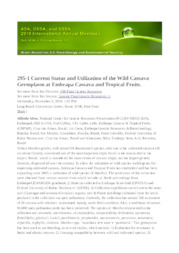Current status and utilization of the wild cassava germplasm at Embrapa Cassava and Tropical Fruits.
Current status and utilization of the wild cassava germplasm at Embrapa Cassava and Tropical Fruits.
Author(s): ALVES, A. A. C.; LEDO, C. A. da S.; COSTA, I. R. S.; MENDES, R.; CARVALHO, P.; SILVA, A. F.
Summary: Within Manihot gender, with around 98 documented species, only one is the cultivated cassava (M. esculenta Crantz), considered one of the most important staple foods in the human diet in the tropics. Brazil, which is considered the main center of cassava origin, has the largest genetic diversity, dispersed all over the country. To allow the utilization of wild species useful genes for improving cultivated cassava, Embrapa Cassava and Tropical Fruits has established and has been expanding since 2005, a collection of wild species of Manihot. The accessions of this collection were obtained from various sources from which include: a) Seeds and cuttings from Embrapa/CENARGEN genebank; 2) Material collected at Embrapa Semi-Arid (CPATSA) and Federal University of Bahia ?Recôncavo? (UFRB); 3) Collection expeditions carried out in the semi-arid (Caatinga) and savanna (Cerrados) regions; and 4) Plants (seedlings) obtained from the seeds produced in the collection via open pollination. Currently, the collection has around 560 accessions of 20 cassava wild relatives, maintained, mainly, under field condition. Also, a seed bank of around 80,000 open pollination seeds has been preserved. The species of Manihot represented in the collection are: anomala, caerulescens, cecropiaefolia, compositifolia, dichotoma, epruinosa, flabellifolia, glaziovii, irwinii, jacobinensis, janiphoides, maracasensis, peruviana, tomentosa, tripartita, triphylla, violacea, Manihot spp., ?mandioca sete anos? e ?pornúncia?. This germplasm has been used in pre-breeding, in several studies, which include: 1) Evaluation for resistance to biotic and abiotic stresses; 2) Crossing compatibility between wild and cultivated species; 3) Development and evaluation of interspecific hybrids; 4) Phenotypic and genotypic characterization; 5) Citogenetics, production, characterization and viability of pollen grains; and 6) Molecular markers screening for resistance to pests and diseases. In this article we describe the steps accomplished to establish this collection and the main results of research activities.
Publication year: 2010
Types of publication: Abstract in annals or event proceedings
Unit: Embrapa Semi-arid Region
Keywords: Diversidade genética, Germoplasma, Mandioca, Manihot, Marcador Molecular, cassava
Observation
Some of Embrapa's publications are published as ePub files. To read them, use or download one of the following free software options to your computer or mobile device. Android: Google Play Books; IOS: iBooks; Windows and Linux: Calibre.
Access other publications
Access the Agricultural Research Database (BDPA) to consult Embrapa's full library collection and records.
Visit Embrapa Bookstore to purchase books and other publications sold by Embrapa.

